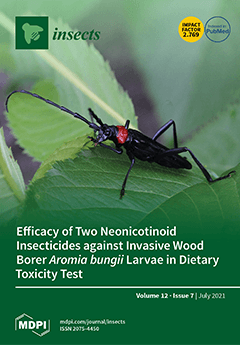With the widespread application of insecticides, parasitoid wasps may also be under risk when exposed to insecticides directly at their free-living stages. The endoparasitoid wasp
Meteorus pulchricornis is the predominant natural enemy of many lepidopteran pests, such as
Spodoptera litura and
Helicoverpa armigera
[...] Read more.
With the widespread application of insecticides, parasitoid wasps may also be under risk when exposed to insecticides directly at their free-living stages. The endoparasitoid wasp
Meteorus pulchricornis is the predominant natural enemy of many lepidopteran pests, such as
Spodoptera litura and
Helicoverpa armigera. The cytochrome P450 monooxygenases constitute a ubiquitous and complex superfamily of hydrophobic, haem-containing enzymes. P450s are involved in the detoxification of many xenobiotics. However, their exact roles in the tolerance mechanism in parasitoids toward insecticides has received less attention. Here, 28 P450 genes in
M. pulchricornis were identified from a previously constructed transcriptome dataset. These P450 genes belonged to CYP2, -3, and -4, and mitochondrial clans. Subsequently, eight candidate
MpulCYPs were selected from four CYP clans to validate their expression patterns under phoxim, cypermethrin, and chlorfenapyr exposure by qRT-PCR. The results showed that all three insecticides had significant effects on the expression of
MpulCYPs. To further study the function of P450s,
CYP369B3 was silenced, and its expression levels of
CYP369B3 were significantly decreased. Survival analysis indicated that after dsRNA injection, the mortality rate of wasps was significantly increased when
M. pulchricornis females were exposed to insecticides compared to control groups. Our findings provide a theoretical base for elucidating the mechanism of insecticide tolerance and promote functional research on P450 genes in parasitoid wasps.
Full article






